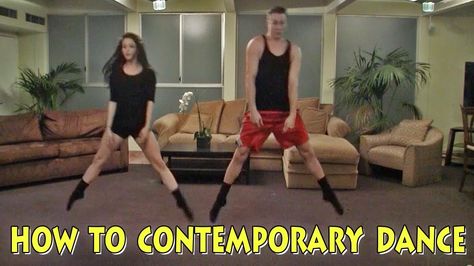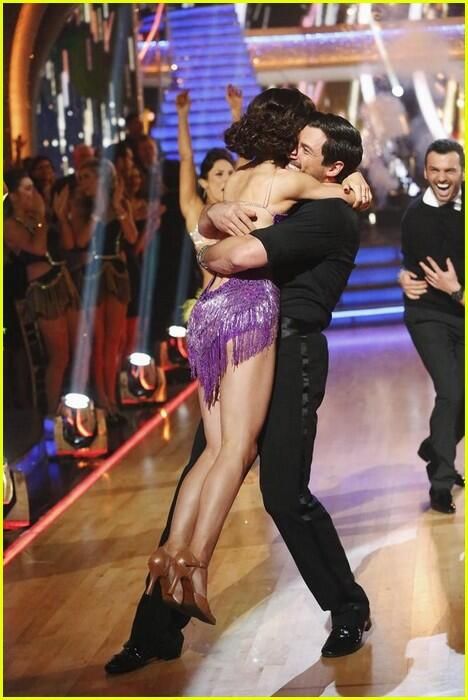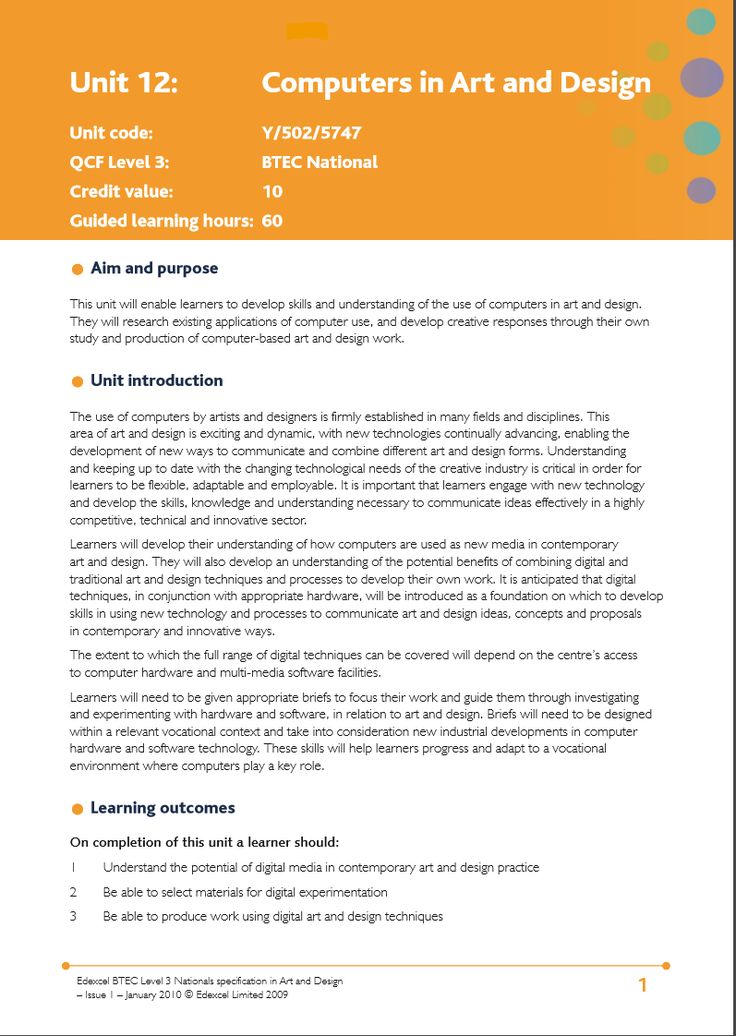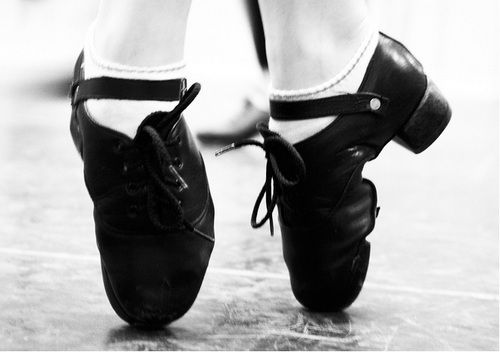How to get more flexible for dance
How to Boost Your Flexibility
"How can I get more flexible?" It's a question every dancer has asked themselves at one time or another. Whether you're attempting your first split or trying to nail a crazy high extension in your new dance uniform, flexibility is one of the key components to being a great dancer. If you want to improve yours, it can certainly enhance your rehearsals in the studio and performances on the stage. Just make sure you take the right approach. Here are some tips to help you in the process.
Tip #1: Take your time.
There's no fast way to get more flexible. So don't look for some quick fix on the Internet that will magically elongate your dance moves. It doesn't exist and you could actually wind up hurting yourself in the process. In fact, when you try to make too much progress too fast, you're going to end up with some kind of sprain or strain in your muscles, tendons or joints.
Instead, take a gradual approach. Try to slowly and patiently improve flexibility so that your muscles have the time they need to safely adapt.
Tip #2: Warm up first.
Another vital tip to improving your flexibility involves warming up first. If you start stretching with cold muscles, you're going to wind up with an injury because your muscles aren't limber and ready to stretch in the way you want them to. Doing so can also cause muscle instability that impacts both your strength and agility.
So rather than jumping into difficult stretches or exercises to enhance flexibility, warm up first with a few minutes of cardio. This can be as simple as some jumping jacks or running in place for a couple of minutes. Then ease yourself slowly into your first stretching pose and take it from there.
Tip #3: Listen to your body.
When it comes to stretching and building flexibility, everyone's body is different. What's easy and comes naturally for one dancer -- who's more limber -- might take months of work for another. That's why it's important to listen to your body and pay attention to what works for you.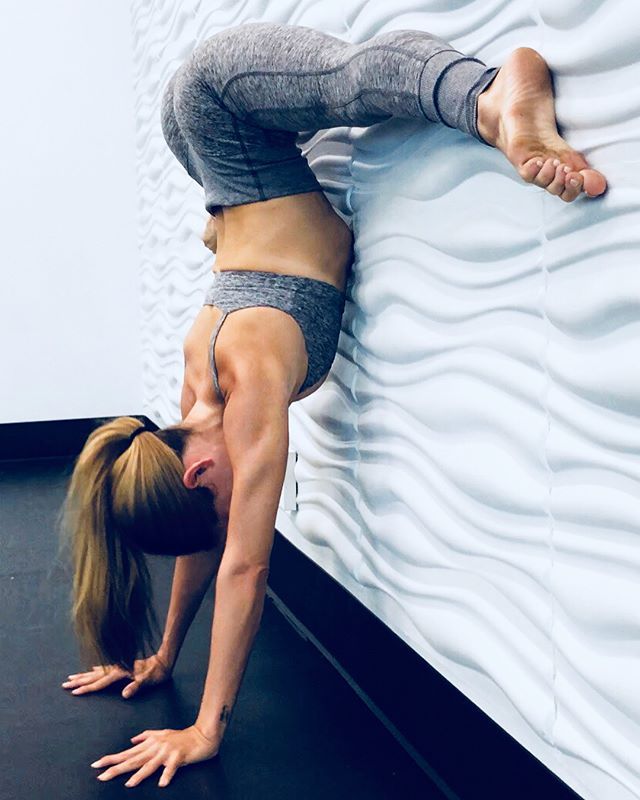 Some dancers are naturally built to be more flexible, so don't compare yourself to others during the process.
Some dancers are naturally built to be more flexible, so don't compare yourself to others during the process.
When you're holding your stretches, also be careful that you don't hold them for too long. In the beginning of class, aim for holding your stretches no longer than 15 seconds. Toward the end of class, however, you can hold stretches for longer - from 60 to 90 seconds.
Tip #4: Perform dynamic stretches before class and static stretches after.
According to Dictionary.com, a dynamic stretch is "a type of sports fitness routine in which momentum and active muscular effort are used to stretch and the end position is not held."
These types of stretches -- such as shoulder rolls, torso twists, and arm swings -- are best used just after warm up, at the beginning of class. Some other good dynamic stretches for the lower body include hip circles, forward and backward lunges, and leg swings. Regardless of which you choose, dynamic stretching is ideal for the start of class because you're getting your heart rate up, while also stretching and warming up muscles.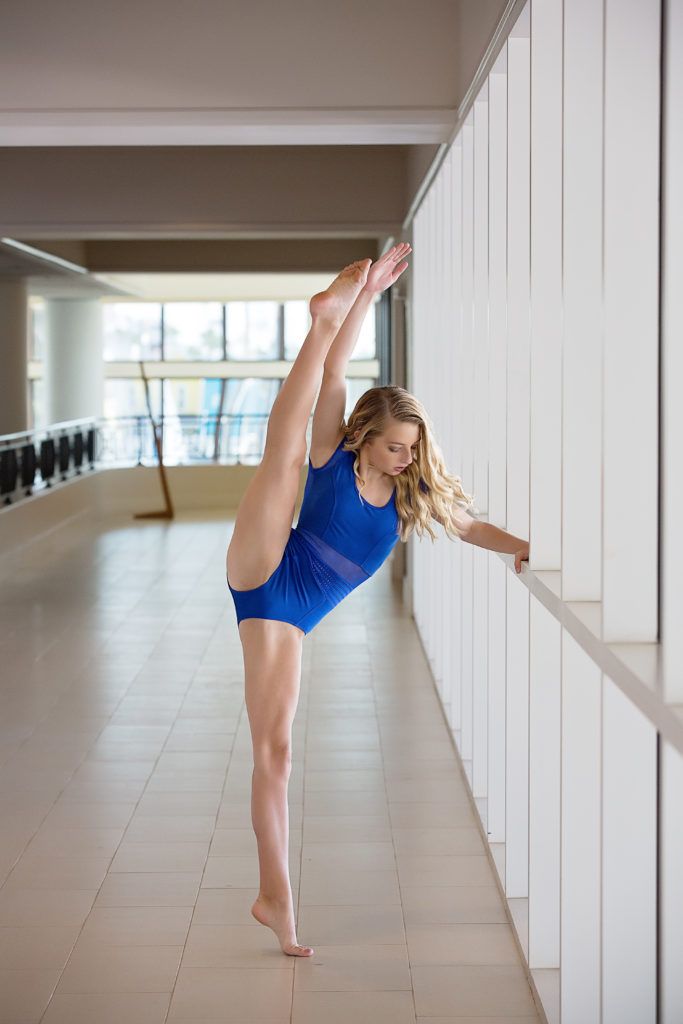
Static stretching, on the other hand, involves holding a certain stretch for a specific period of time. This is usually best done toward the end of class, during your cool down period. You should hold these stretches for at least 30 seconds, or even up to 60 or 90 seconds -- especially if you have a particular muscle you're trying to enhance flexibility in. At the end of your dance class, your muscles will be nice and limber, so you'll be able to push them further during static stretches.
Both dynamic and static stretches are good ways for dancers to improve their flexibility. However, it's best to avoid ballistic stretching, which incorporates bouncing movements where the muscles and tendons are rapidly stretched and relaxed. This can cause strain and can even damage tendons, joints and muscles.
Tip #5: Use strength training.
If you're trying to improve your flexibility as a dancer, then add some strength training to your workout routine mix. While flexibility improves the length of your muscles, strong muscles mean you can hold your dance positions for longer.
Tip #6: Don't push too hard.
If you're having sharp or severe pain, chances are, you've taken things too far. Don't continue on or try to push through the pain. Pain is your body's way of signaling that something is wrong. Likewise, don't stretch for too long before a big performance. Doing so can actually cut down on your ability to perform your jumps properly.
At Just for Kix, we offer all styles of dance uniforms and dance wear that are both stylish, as well as comfortable and functional. From hip hop pants to crop tops and sweatshirts, we've got you covered (literally)! Shop now and check out our collections.
Request a Just For Kix Catalog!
So you want to be flexible... — A Dancer's Life
L: Hyperextension R: Normal knee
There's always that one person in every class whose bones seem to be made of rubber (if indeed, there are any bones!) and who can lounge around in splits just as easily as they can hold a split penché; which is to say, effortlessly.
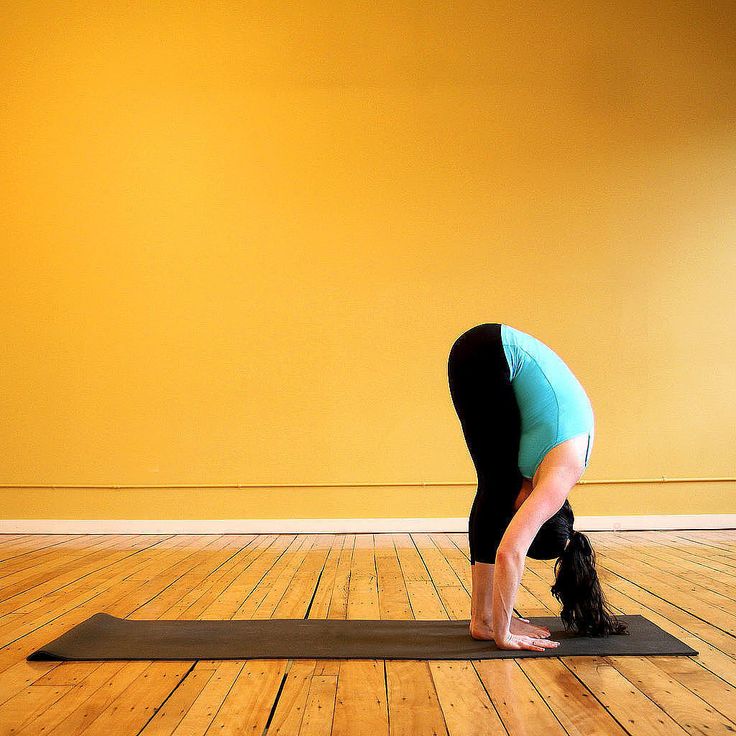 Now, this person might be you, but if it isn't.. fear not! We've got some helpful pointers to get you on track to acing that arabesque! First of all, it's important to remember that just as we are born with different body types, there are different types of flexibility too. What we mean by this, is that certain people will be born with a naturally higher capacity for flexibility. Bodies vary greatly from person to person and some people will have longer muscle fibers, allowing them to stretch their muscles further, and with more ease - and some people will have shallower, less restrictive joints and sockets, giving them a greater range of movement (you know those people with hyper-extension in their knees and elbows, yep, that's them) being 'flexible' is going to come a little easier to these individuals.
Now, this person might be you, but if it isn't.. fear not! We've got some helpful pointers to get you on track to acing that arabesque! First of all, it's important to remember that just as we are born with different body types, there are different types of flexibility too. What we mean by this, is that certain people will be born with a naturally higher capacity for flexibility. Bodies vary greatly from person to person and some people will have longer muscle fibers, allowing them to stretch their muscles further, and with more ease - and some people will have shallower, less restrictive joints and sockets, giving them a greater range of movement (you know those people with hyper-extension in their knees and elbows, yep, that's them) being 'flexible' is going to come a little easier to these individuals.Miss/Mr flexible that we were talking about above will probably fall into this category, so it's important not to get frustrated or annoyed with yourself if you've been trying for ages and you still can't touch your toes to your head whilst they can.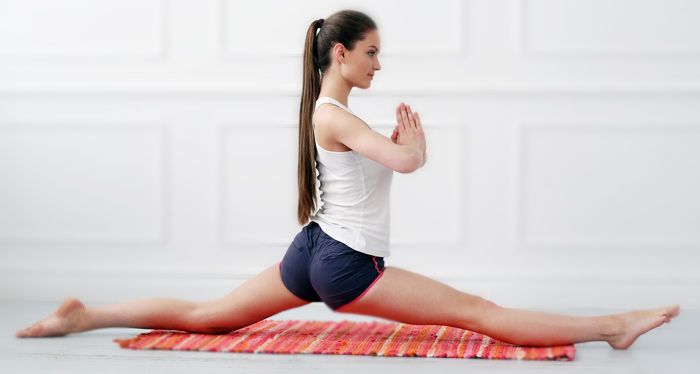 .. It's okay, have a brief Lion King moment* and then get on with it. The key is to remember that how you start does not determine how you finish, just because you couldn't touch your toes in the beginning (and everyone else could) doesn't mean you won't be knocking everyone over with a perfect Grand Battement a little down the track. It's all up to you.
.. It's okay, have a brief Lion King moment* and then get on with it. The key is to remember that how you start does not determine how you finish, just because you couldn't touch your toes in the beginning (and everyone else could) doesn't mean you won't be knocking everyone over with a perfect Grand Battement a little down the track. It's all up to you.
*Scar: giving us a life lesson
So, you've accepted the fact that you're not the most flexible.. yet, and that getting flexible is hard, but you also know that flexibility is an important physical advantage, if not a necessity, for a dancer (and that you reallllyy want to have Darcy Bussel's arabesque, and split kicks like those dancers on SYTYCD!) now what are you going to do about it? Well, these exercises for starters!
Remember: Make sure your body is adequately warm (see our warm-up guide here) before you begin these stretches to prevent muscles seizing up and causing injury to yourself.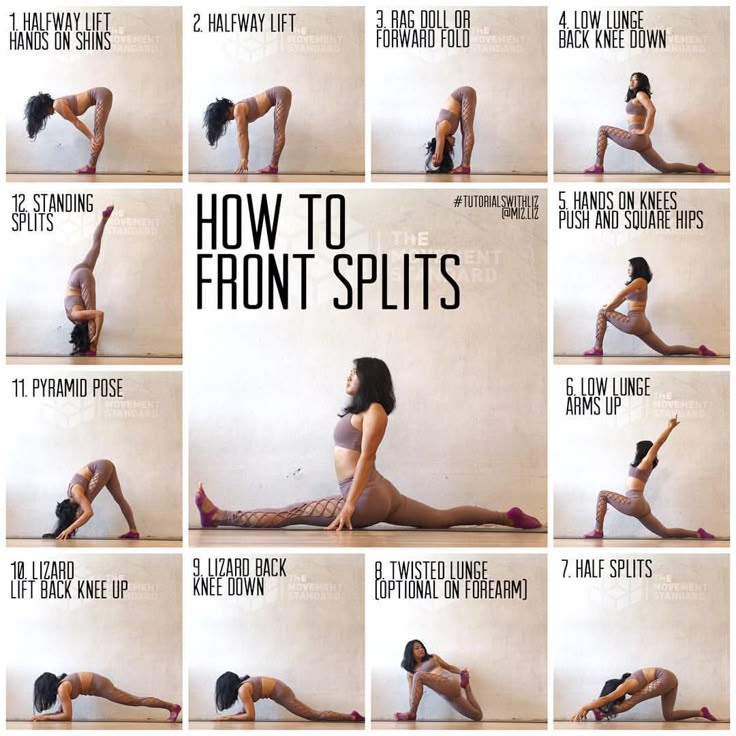 Don't push yourself too hard in one go, keep in mind that long term improved flexibility is much more rewarding than being uber flexible for one day, and then being so stiff you can't stretch all week!
Don't push yourself too hard in one go, keep in mind that long term improved flexibility is much more rewarding than being uber flexible for one day, and then being so stiff you can't stretch all week!
1. Stretching for back flexibility.
Lower back stretches. To begin, start by laying stomach side-down on the floor, legs straight out arms bent with hands placed next to either armpit, elbows by your side. Push the upper body up of the ground and towards the ceiling, keeping the hips firmly on the floor and pushing back away from your hands to give your back a gentle stretch (See Image 1.). Return to the neutral lying position, this time with arms by your side and bend the knees so that the feet are brought up and in towards the back. Reach your hands up and take hold of your ankles and pull the legs up and over towards the head whilst simultaneously lifting the torso up off the ground towards your feet (See image 2.).
Basic lower back stretch.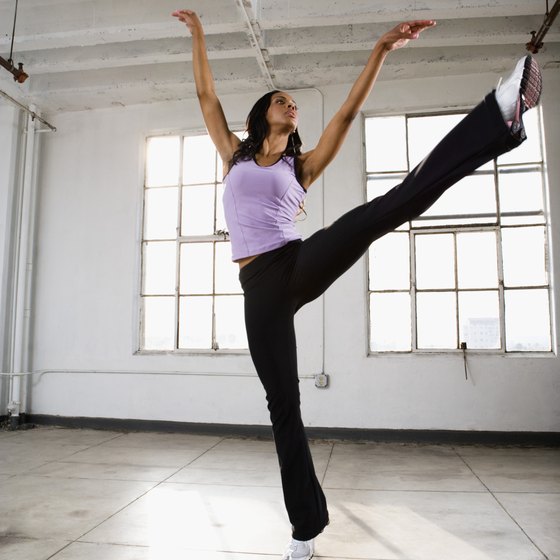
The second back exercise
Upper Back Stretches. Next, kneel on your knees, with the feet flat to the ground (so tops of the feet will be against the floor) and keeping everything below the hips vertical, lower the upper back and head backwards over the legs, allowing the arms to remain by your side. Go back as far as you need until a stretch is felt in the upper back (see Image 3.), if this is quite easy then raise the arms above the head and repeat, allowing the the pelvis and upper legs to also tilt backwards with the aim being placing your hands (stretched up above your head, not by your side as before), and finally your head on the floor (See Image 4.). This should also gently stretch your quadriceps.
Basic stretch
The advanced stretch
Advanced bridge: This is a great stretch to further increase your flexibility if you're comfortable doing a bridge (see Image 5. ) - If this stretch is still a little difficult for you then just keep practicing bridges, and re-asses in a couple of weeks. - Once you are up in a bridge shift your body so that your weight rests primarily over the arms, and gradually try to straighten you knees. This is very effective in stretching out the upper back and shoulders (See Image 6.). Don't worry if you can't get their just yet, gentle daily repetition will lead to gradual but significant improvement. If you can easily straighten your knees then relax back to a normal bridge, walk the hands a little closer to your feet and repeat until a reasonable stretch is felt. From here the next step is to bend the knees once more and lower yourself down so that your upper body is supported on your elbows, and your hands are folded under your head (see Image 7.)
) - If this stretch is still a little difficult for you then just keep practicing bridges, and re-asses in a couple of weeks. - Once you are up in a bridge shift your body so that your weight rests primarily over the arms, and gradually try to straighten you knees. This is very effective in stretching out the upper back and shoulders (See Image 6.). Don't worry if you can't get their just yet, gentle daily repetition will lead to gradual but significant improvement. If you can easily straighten your knees then relax back to a normal bridge, walk the hands a little closer to your feet and repeat until a reasonable stretch is felt. From here the next step is to bend the knees once more and lower yourself down so that your upper body is supported on your elbows, and your hands are folded under your head (see Image 7.)
The bridge.
Head to floor
Stretch for Arabesque/attitude: Now for a stretch that will aid with increasing your splits and back flexibility, improving the line of your arabesque/attitude and lengthening the quadriceps.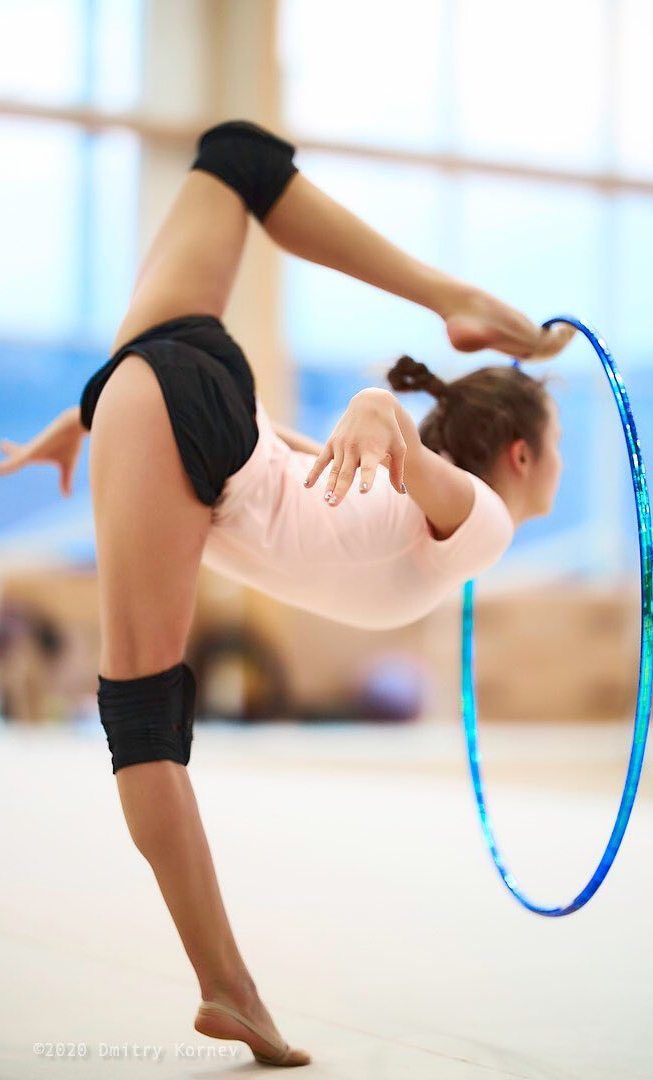 Using a theraband, bend one leg backwards at the knee, and with one end of the theraband grasped in each hand, loop the centre over the flat top of your foot. Sometimes it can be good to have someone supporting you as you do this (but not necessary), once you've steadied your balance, begin to extend the leg up and backwards, keeping the supporting leg straight, as well as tension in the theraband and using it to pull your leg up and over your head. Make sure you don't let the upper body collapse, but hold yourself upright with as straight a back as possible (See Image 8.). Try to hold it here for 10 to 15 seconds and then repeat with the other leg.
Using a theraband, bend one leg backwards at the knee, and with one end of the theraband grasped in each hand, loop the centre over the flat top of your foot. Sometimes it can be good to have someone supporting you as you do this (but not necessary), once you've steadied your balance, begin to extend the leg up and backwards, keeping the supporting leg straight, as well as tension in the theraband and using it to pull your leg up and over your head. Make sure you don't let the upper body collapse, but hold yourself upright with as straight a back as possible (See Image 8.). Try to hold it here for 10 to 15 seconds and then repeat with the other leg.
Stretching for Splits/Arabesque
2. Stretching for splits / leg flexibility.
Inner thigh / Middle Splits stretches. The next few stretches will focus on improving the flexibility in your inner leg (adductors), hamstring and gluteal muscles to aid in getting a flatter side splits and higher kicks/battements.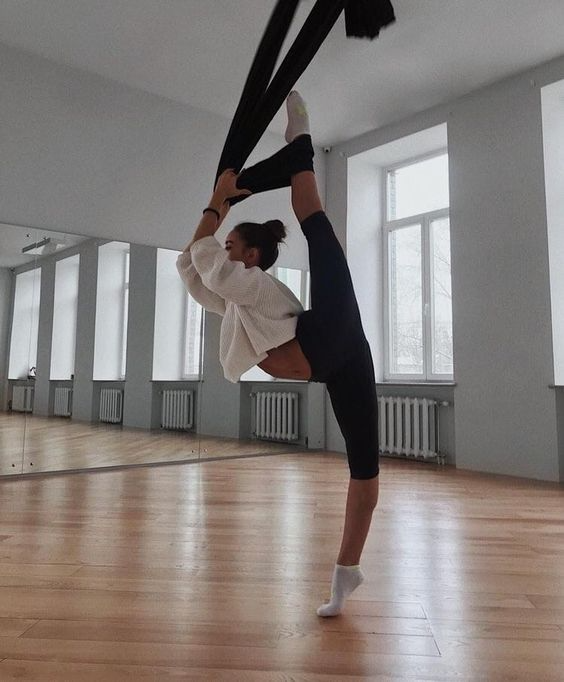 Remember to breathe and relax into the stretch, never force or 'bounce' it!
Remember to breathe and relax into the stretch, never force or 'bounce' it!
Standing Straddle Stretch: From a neutral standing position, split the legs so that the distance between the heels of the feet is approximately one and a half times the width of your shoulders, or a little wider, and you are now standing in a straddled position, with your feet facing forwards in a slight turn-out. Shift the torso to your right, so that the upper body is in line with the right leg and gradually lean forward trying to keep the spine relatively flat. At the same time use your hands to wrap around your ankle and gently pull the body closer; You should be aiming to press the entire upper body against your leg with the head reaching as close to the ground as possible (See image 9.). Return to the upright 'straddle' position and repeat to the left side. Perform the stretch again, this time keeping the upper body over the middle of the legs and leaning forwards, one hand on each ankle, until the chest is almost in between the legs, or as close as possible (See image 10.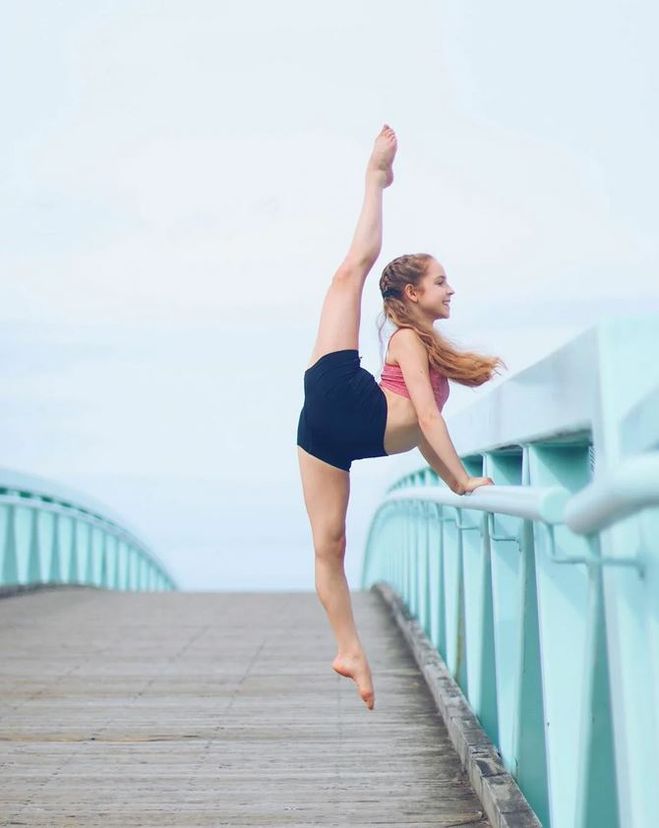 ).
).
Focus on getting the stomach and chest flat, rather than just the head.
View fullsize
View fullsize
Frog and Butterfly Stretch: Now for some floor stretches that will greatly improve your middle splits, hip range, and also your turnout. Please keep in mind that people with a very limited range of movement in their hips sockets may find these stretches to be too uncomfortable, so make sure you modify your routine as needed, not all stretches are suited to everyone which is why it's important to listen to your body.
Start sitting on the floor with your knees bent and the soles of your feet pressed together, legs drawn in and hands resting on your ankles. Gradually press your knees down towards the ground until a stretch is felt (See image 11), if no stretch is felt and knees can be flattened easily then hold the legs down, and keeping a long spine gradually bend forwards with the aim of touching your forehead to the your toes.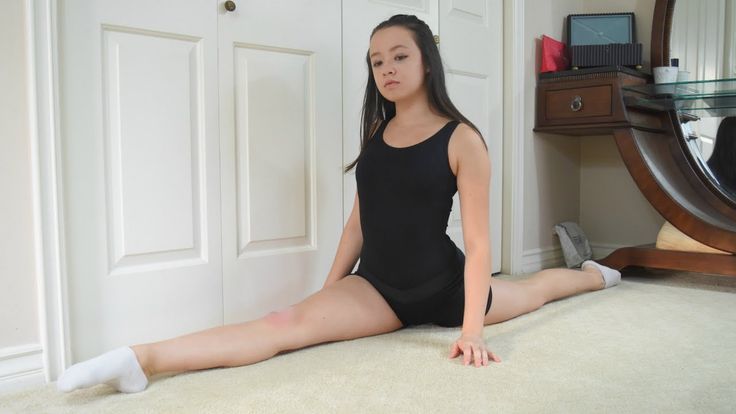
Keeping good posture is essential.
Next, position the body so that you're resting on your elbows and knees, back straight, and gradually spread the knees apart, pressing the hips down towards the floor and making sure you keep the knees in line with the hips (this bit is important!). It is helpful if you can get a friend or partner to gently press down on the lower back to increase the stretch. Once you have gone as far as you can, take several deep breaths and relax into the position, holding for 20 - 30 seconds before relaxing.
Finally, lay flat on the ground, stomach to the floor and draw the legs up in a turned out position with the soles of the feet touching (Don't sickle!). Keep bending the knees until you're in the 'frog position'. Unlike the previous stretch where the hips had to be held directly over the knees, the focus of this exercise is to keep the pelvis firmly connected to the floor, aiming also to get the ankles as close to the ground as possible.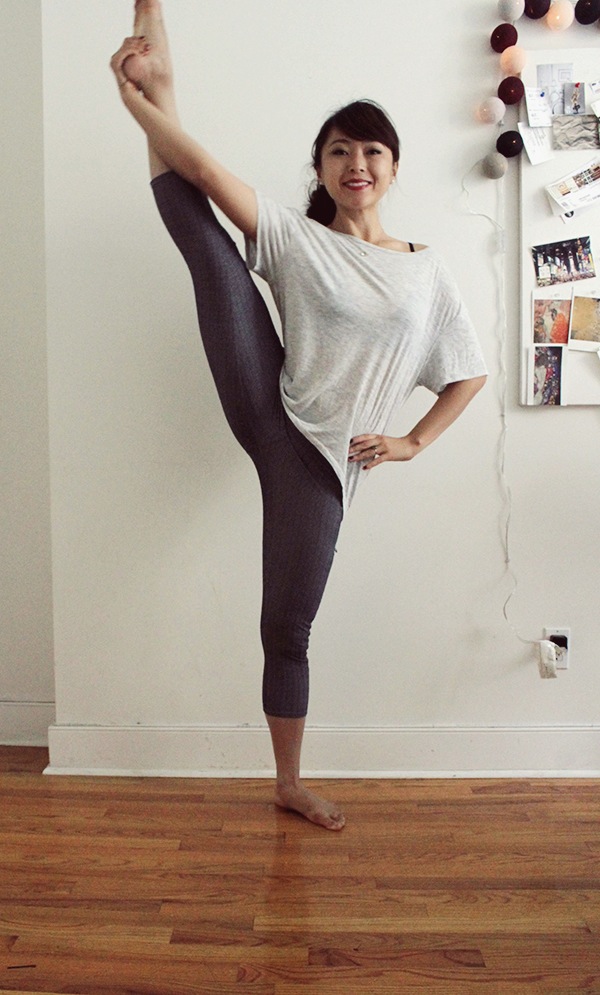 Don't be worried if your feet are stuck up in the air to begin with, some people will be more limited by their hips sockets (and turn-out capabilities) than others, and some will be able to get their hips and ankles to the ground immediately (See image 13.). Practice is the key here, with repetition everyone has the potential for improvement.
Don't be worried if your feet are stuck up in the air to begin with, some people will be more limited by their hips sockets (and turn-out capabilities) than others, and some will be able to get their hips and ankles to the ground immediately (See image 13.). Practice is the key here, with repetition everyone has the potential for improvement.
Hips remain pressed to the floor as knees draw in.
Next, sit up with your legs stretched out to the sides (in a relaxed middle split position) and make sure your toes are facing up towards the ceiling with no rolling forwards. If you like, you might find it beneficial to sit with your back against a wall to ensure you're not sinking or collapsing your posture. Now reach your left arm up from the side, and over your head, and still facing forwards bend towards your right leg, trying to feel the stretch all along the leg and up your side (See image 14.). Keep going until you feel a stretch and then hold for a count of 10. Relax, and repeat on the other side. Now repeat the exercise, this time shifting the upper body towards the leg and flattening all the way from your lower spine to your head until you are folded over your leg (See image 15.). This should give you a completely different stretch, as you engage new muscles to the ones targeted in the previous exercise. Once again hold the position for a count of 10 and repeat on the other side. Finally, return to the upright, forward-facing position and placing your hands in the centre, begin to walk them forward away from your body, allowing the chest to eased forward with them. Maintaining a straight a spine as possible, lower yourself towards the ground as you continue to walk the hands out. As you do this you should find your pelvis also rotating a little and coming forwards, placing you in a deeper, flatter middle split. Make sure to pause every few beats and take a couple of deep breaths, and then creep the hands forward a little further and repeat until hopefully you look like this (See image 16.
Relax, and repeat on the other side. Now repeat the exercise, this time shifting the upper body towards the leg and flattening all the way from your lower spine to your head until you are folded over your leg (See image 15.). This should give you a completely different stretch, as you engage new muscles to the ones targeted in the previous exercise. Once again hold the position for a count of 10 and repeat on the other side. Finally, return to the upright, forward-facing position and placing your hands in the centre, begin to walk them forward away from your body, allowing the chest to eased forward with them. Maintaining a straight a spine as possible, lower yourself towards the ground as you continue to walk the hands out. As you do this you should find your pelvis also rotating a little and coming forwards, placing you in a deeper, flatter middle split. Make sure to pause every few beats and take a couple of deep breaths, and then creep the hands forward a little further and repeat until hopefully you look like this (See image 16.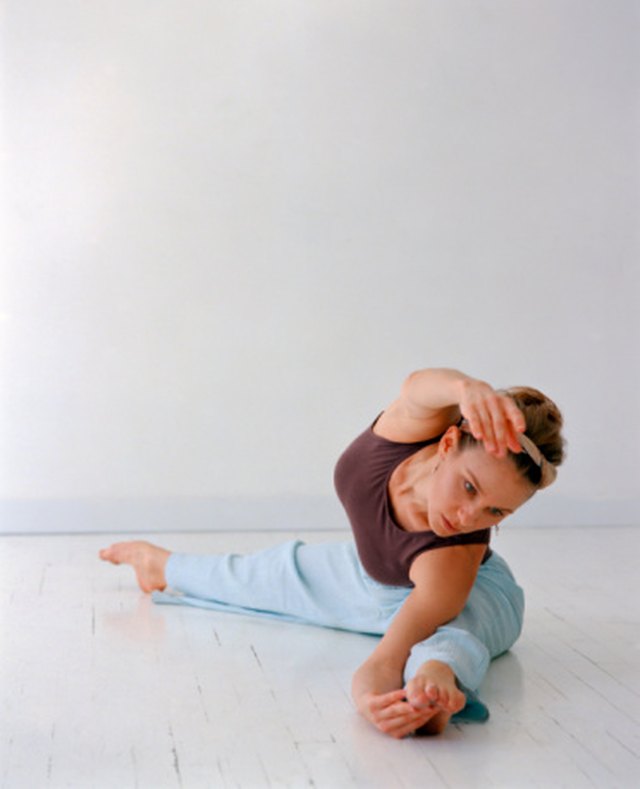 )! Once you relax from the stretch be sure to shake your legs out a little bit so your muscles aren't storing the tension.
)! Once you relax from the stretch be sure to shake your legs out a little bit so your muscles aren't storing the tension.
Toes facing upwards, upper body facing forwards.
The body has now shifted to face the leg, toes remain pointed towards the ceiling (they may be flexed or stretched according to preference).
Flatten from the lower spine, so the back stays as flat as possible, this provides a much more effective stretch.
Et Voila! There you have it; A selection of fantastic stretching exercises that will help you improve your flexibility in leaps and bounds (not without practice and dedication though)!
Article by Elly Ford
Read Next:
Preventing Muscle Soreness
Pointe Shoes the Perfect Fit
Coping with Injury
Dance Advice, Fitness, New to Dance, Advice + Tips, Health + FitnessEnergetiksdance, stretching, dance advice, tips, ballet tips, flexibility, flexibility tips, splits, flexible, stretching tutorial, ballet stretches, dance stretches, So you want to be flexible, Elly Ford7 Comments
0 LikesHow to become more flexible
Stand up right now, bend over and try to touch your toes.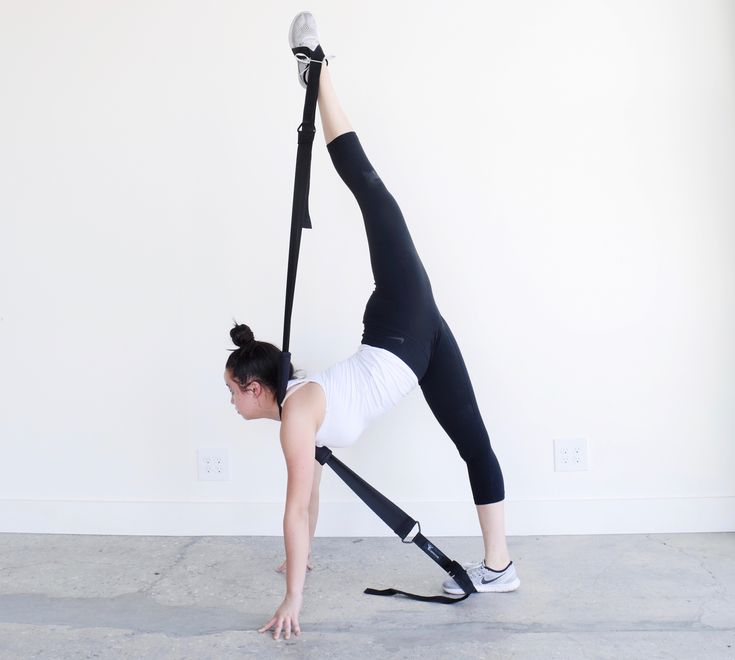 It turns out? If this is a difficult task for you, then you should think about developing flexibility.
It turns out? If this is a difficult task for you, then you should think about developing flexibility.
This does not require hard training. It is enough to devote a couple of minutes a day to simple breathing exercises and stretching. Let's see why every person needs to develop flexibility and how to do it.
Why Flexibility Matters
Flexibility is the ability of your muscles and other connective tissues to stretch temporarily. In everyday life, we rarely think about how important this is. However, even simple actions like pulling up on a shelf or picking up a dropped item from the floor require flexibility.
If your muscles are not flexible, everyday activities will become more difficult to perform. Improving flexibility is also necessary to relieve muscle tension, develop physical strength and endurance.
Workout Schedule
If you want to improve your body flexibility, the best option is to combine breathing work, static stretching and dynamic stretching. Combining exercise with strength training can improve your flexibility and mobility faster.
Combining exercise with strength training can improve your flexibility and mobility faster.
The effect can be achieved by breathing and stretching for 10 minutes a day. If you're worried you'll forget about your workouts, you can make stretching part of your routine: exercise in the morning or before bed.
Things to consider before exercising
To get the most out of flexibility training, keep the following in mind:
- Try to do flexibility training at least three times a week for 10-15 minutes.
- Perform each exercise below for 15 to 30 seconds. After that, take a break and repeat again.
- If you are combining exercises with strength training, perform dynamic stretching before training and static stretching after. Static stretching is usually safer and more effective when performed on warm muscles.
Breathwork
Proper breathing is the basis of all exercises. Especially stretch marks
Breathwork is designed to teach you how to breathe more efficiently and with less energy.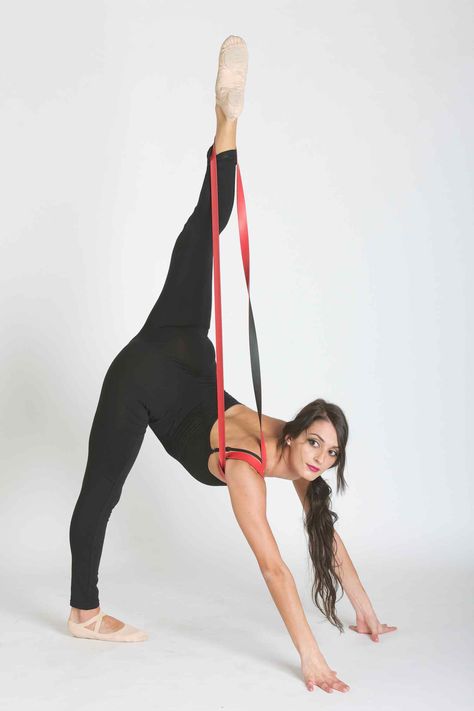
Exercise also engages and strengthens the diaphragm and core muscles.
Sitting Inhale and Exhale
Use diaphragmatic breathing by moving your arms up and down.
- Sit cross-legged. Hands down.
- Inhale and raise your arms above your head.
- Exhale and return your arms to the starting position.
Sitting Side to Side Stretch
Use diaphragmatic breathing and start stretching your torso from side to side.
- Sit cross-legged. Hands down.
- Inhale and raise your right arm above your head to the left, stretching your right side.
- Exhale and return to the starting position.
- Inhale and repeat with the other hand.
Lying Turns
Focusing on your breath while lying turns will allow you to stretch more effectively.
- Lie on your back.
- Extend your arms into a "T" shape and twist your lower body to the right, bending your left leg and leaving your left knee on the ground.
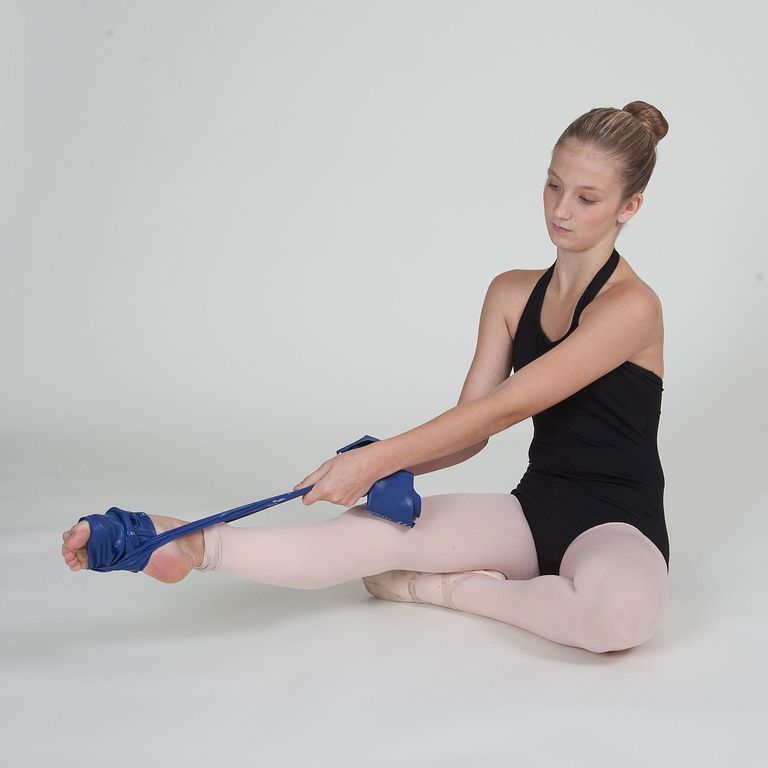
- Keeping your shoulders on the floor, turn your head to the left.
- On each exhalation, let your body relax a little in the stretch.
Static Stretches
Static stretching is a great way to improve flexibility. This is when you stretch and hold it without moving for a certain period of time.
There are a few things to keep in mind when doing a static stretch:
- Warm up your muscles beforehand. Spend 5-10 minutes doing a low-intensity warm-up. For example, take up walking. Stretching without warming up can increase the risk of injury.
- Do not make sudden movements. It can also lead to injury. Instead, hold the point of tension for 15 to 30 seconds, then relax and repeat the exercise again.
- Do not try to do everything through pain. Stretch to a point of tension and stop. Overexertion can lead to a negative effect of training.
- Remember to breathe while exercising.
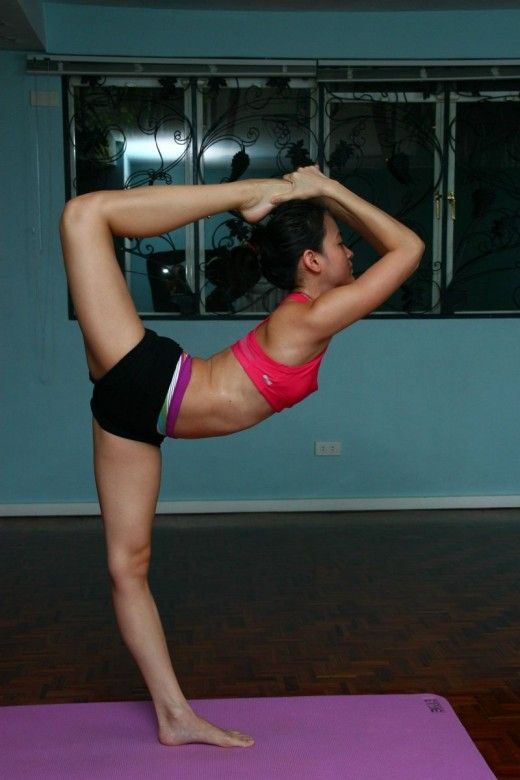 Try to practice diaphragmatic breathing whenever possible.
Try to practice diaphragmatic breathing whenever possible.
Bends
Forward Bends stretch the entire back of your body: calves, hamstrings, glutes and spine.
- With your feet together, lean forward. While bending, lower your head to your knees and your hands to the ground or to the ground.
- Do not bend your knees, straighten your legs as much as possible.
- If necessary, bend your knees slightly until your hands touch the ground.
Sitting Torso Stretch
This exercise will provide a good stretch for your spine and muscles around the buttocks.
- Sit on the floor with your right leg extended and your left leg crossed over your right. The left foot is on the floor.
- Rotate your torso to the left, pressing your right hand against your left thigh for tension.
- Breathe in while stretching, breathe out when changing positions.
Hip stretch
If you have a mostly sedentary lifestyle, this exercise will probably be a challenge for you.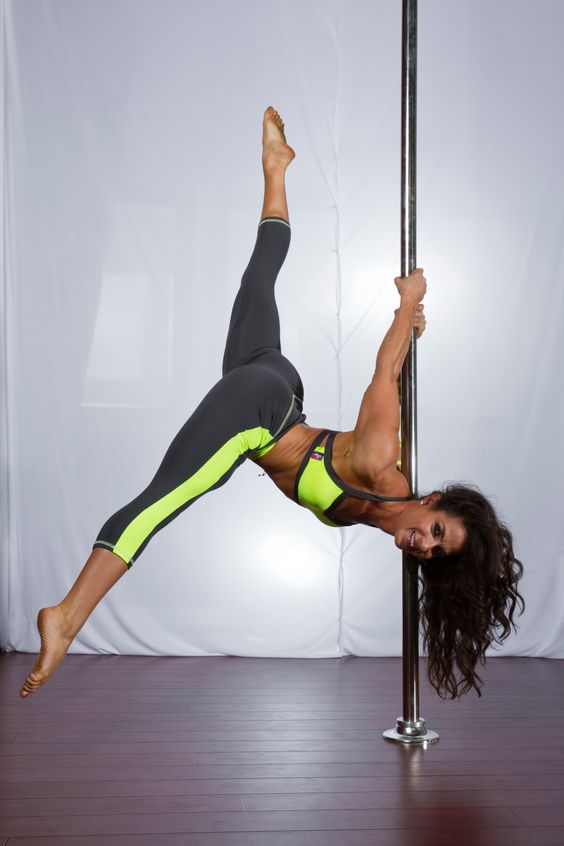
- Get into a lunge position with your right foot forward. Make sure your right knee is at a 90 degree angle.
- The left knee must rest on the floor.
- Place both hands on your right leg for balance and keep your back straight.
- Gently bend back and stretch until you feel tension.
- Repeat with the other leg.
Dynamic Stretches
Another way to improve flexibility and mobility is dynamic stretching.
Instead of taking a position and holding it, dynamic stretching forces the muscles and joints through a full range of motion. This is a great pre-workout warm-up.
Front swing
This exercise helps to relax the thigh muscles during movement.
- Stand next to a wall or other stable surface to balance with your arm.
- Begin gently swinging the foot further away from the point of balance back and forth. Strive to raise your leg as high as possible.

- Perform the exercise with the other leg.
Arm circles
Relax your shoulders and upper back with arm circles.
- Stand up and place your feet shoulder-width apart, hands at your sides.
- Raise your straightened arms up in front of you, then back behind your head and back. Try to draw a circle with your fingertips.
- Try to keep your arms straight at all times and keep them as close to your ears as possible.
- Repeat the exercise moving the arms in the opposite direction.
Knees Raised
This movement will cause blood to be pumped to your lower extremities while stretching the muscles of your buttocks, thighs and knee joints.
- Stand up and place your feet shoulder-width apart.
- Dynamically raise your knees one by one.
Strength Training
While you can think of stretching as a way to increase flexibility and mobility, strength training can also improve both. This happens if they are performed correctly and with a full range of motion.
This happens if they are performed correctly and with a full range of motion.
Instead of taking a position and holding it, dynamic stretching forces the muscles and joints through a full range of motion. This is a great pre-workout warm-up.
Squats
Squats will get your lower body in great shape.
- Stand with your feet slightly wider than shoulder width apart. The toes are slightly apart.
- Begin a squat at the hips, then bend your knees to lower yourself down (as if you were about to sit on a chair).
- Stretch your arms out in front of you and keep your knees locked in the same position.
- Stop when your thighs are parallel to the ground. Then return to neutral.
Back Lunge
This exercise will stretch the muscles in your torso.
- Get up. Place your feet shoulder-width apart, arms at your sides.
- Lunge forward with your right foot, right knee at 90 degrees.
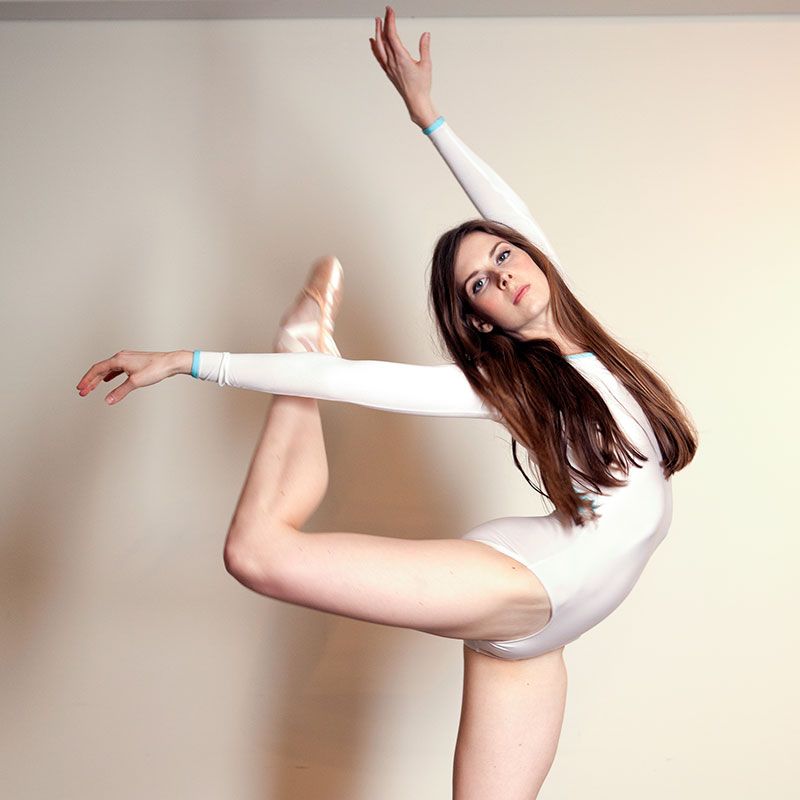
- Raise your arms straight above your head and gently lean back, feeling the stretch in your body.
- Hold this position for 5 to 10 seconds. Then return to the neutral position.
- Alternate legs during the repetitions of the exercise.
Bent Swallow
With this exercise, you will stretch and strengthen the back of your body.
- Stand with your feet shoulder-width apart, arms at your sides.
- Inhale and lean forward, bringing the straightened right leg back. The left knee, if necessary, can be in a bent position.
- Repeat the exercise several times and change legs.
Common Mistakes
It is important to listen to your body with any stretch.
If you begin to feel pain or discomfort, stop the exercise immediately. You run the risk of overstretching the muscles or even tearing them.
Stretch to a point of tension while holding.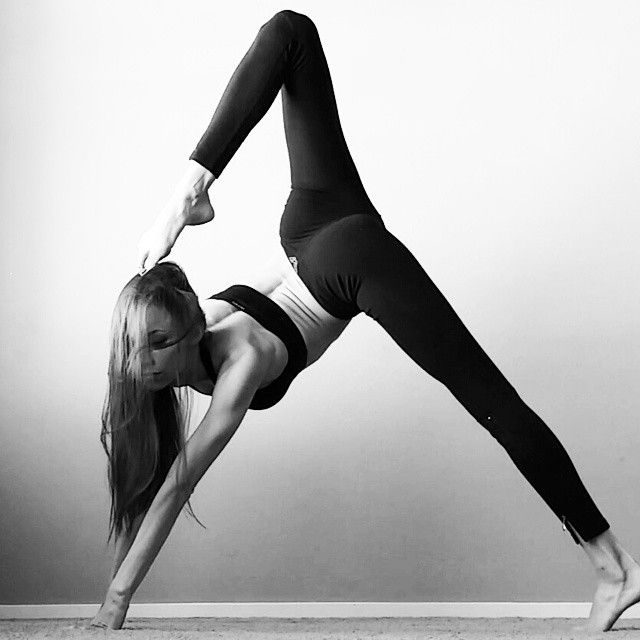 With a consistent increase in load, you will quickly gain flexibility.
With a consistent increase in load, you will quickly gain flexibility.
Stretching just 30 minutes a week can greatly increase your flexibility.
Good flexibility brings many benefits, the most important of which is your quality of life. And for training, you may need sports goods. It's never too late to start!
Still have questions?
Consult with our managers - they are professionals.
Your first name
Your last name
Phone
Message
types of flexibility and basic stretching exercises
Contents
A flexible body, elastic muscles and mobile joints are the key to beauty and health at any age. Flexibility is not only innate, but also an acquired quality. Without a doubt, every dancer should have it.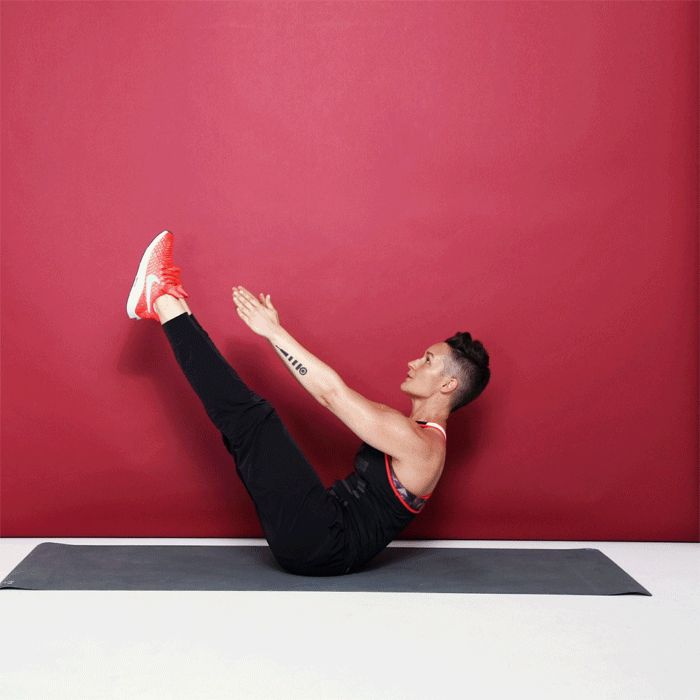
What is flexibility
Flexibility is the ability of the body, namely muscles, ligaments and joints, to give maximum amplitude in various movements and physical exercises.
The flexibility of the body depends on genetics, the structure of the joints, the elasticity of the tendons. This indicator is also related:
- with age. Children and adolescents tend to be more flexible than adults;
- with floor. Women are naturally more flexible than men;
- with the level of physical fitness and fitness.
Types of flexibility, as it happens
There are several varieties:
- Dynamic flexibility is the maximum possible range of motion in the joint in the absence of any outside help. For example, standing against a wall, the athlete raises the leg to the highest possible level and holds it for several seconds. Also, the dynamic view is fixed when performing exercises, for example, with swings;
- Passive (static) flexibility always exceeds active dynamic.
 It is achieved with an external impact on the joint. For example, the athlete or his partner holds the raised leg with the hand in maximum amplitude;
It is achieved with an external impact on the joint. For example, the athlete or his partner holds the raised leg with the hand in maximum amplitude; - Special refers to the mobility of specific joints. Different sports and dances require different levels of joint mobility;
- Anatomical. Habitual daily movements in terms of joint mobility are very limited. Use of the reserve of pledged flexibility up to 95% occurs only during special classes;
- Excessive flexibility is dangerous, as the stability of the joint is lost and the maximum stretching of muscles and ligaments is reached. This is fraught with injuries (dislocation, rupture, sprain).
Sign up for a trial lesson
Why flexibility is important for dancers
Good flexibility is the key to beautiful amplitude movements and speed of changing positions
A flexible body is more responsive, flexible and enduring.
Good amplitude in the work of all joints gives excellent coordination between all parts of the body.
These motor indicators are extremely important in dance. Movable joints and stretch-responsive muscles make the body supple, able to quickly perform complex movements and ligaments.
Flexibility can be improved by regular stretching.
What exercises help to develop flexibility
Stretching (from the English "stretching") always begins with a quality warm-up of the whole body. Pulling muscles and ligaments is possible only in a heated state. To do this, it is enough to perform a warm-up of 2-3 dynamic exercises, involving all the main joints.
Flexibility exercises:
- Neck . Grab your head with your right hand and press your ear against your right shoulder, stretching the left side of your neck. Lock the position for 30 seconds. Repeat with your left hand.
- Spine, thoracic .
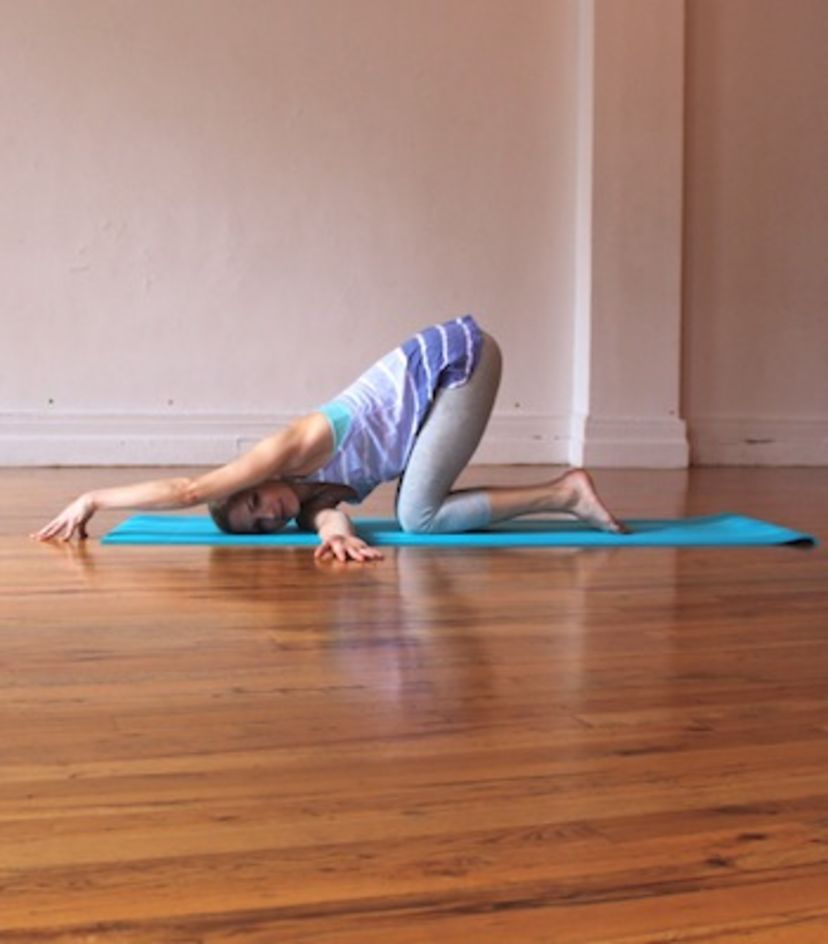 Starting position on all fours. Bend your back down and lift your head up, remaining in the position for 10-15 seconds. Arch your back up, lowering your head down. Hold the position for another 15 seconds. Repeat several times at a slow pace.
Starting position on all fours. Bend your back down and lift your head up, remaining in the position for 10-15 seconds. Arch your back up, lowering your head down. Hold the position for another 15 seconds. Repeat several times at a slow pace. - Spine, back of thighs . An exercise from the arsenal of yoga "Downward Dog". Place your feet and hands on the floor shoulder-width apart and bring them closer until you reach the body in an inverted V. The foot is completely on the floor, legs are straight. For greater effect in position, you can sway slightly, creating a arch in the back.
- Spine, core muscles . Lying on your stomach, bend your knees, bring your feet to your buttocks. Wrap your arms around your feet and pull your legs back and up. The thoracic spine takes the maximum deflection. The position is fixed for 20-30 seconds.
- Hip extension .
 Lunge forward with your right foot and shift your weight onto it. Tilt your body forward and lean on your elbows. Maintain the position for up to 30 seconds. Repeat with the other leg.
Lunge forward with your right foot and shift your weight onto it. Tilt your body forward and lean on your elbows. Maintain the position for up to 30 seconds. Repeat with the other leg. - Lateral Thigh Extension . Sitting on the floor, spread your legs as wide as possible. Place your body and arms on the floor as far as possible. Stay in position for up to 30 seconds.
Tips from experienced choreographers for stretching
Flexibility exercises are performed at a calm pace, the muscles are stretched until a slight tolerable pain appears. In each position, you should stay up to 20-30 seconds, holding the maximum amplitude of the stretch.
For general flexibility development, it is enough to stretch 1-2 sessions per week as a small addition to the main workout. The presented set of flexibility exercises is one of the possible options for this form of training.
If increasing the flexibility of the body is the main task, then it is worth doing stretching in the format of a full-fledged lesson.


